Game localization has become a cornerstone for developers aiming to expand their audience and boost sales globally. But how significant is its impact? Let’s take a look at a few examples that highlight the ROI of game localization and how it influences game discovery and sales, from real-world data.
What is the ROI of Localization
When discussing the ROI of game localization, we’re talking about the tangible returns developers receive for investing in localizing their games to different languages. On top of the financial metrics, localization also influences game visibility, player engagement, and overall market reach.
The GameDiscoverCo article by Simon Carless offers valuable insights into the effect of localization on game discovery and sales, with data from three games: Slay the Princess, Against the Storm, and Nebulous: Fleet Command.
How Localization Affects Game Discovery
One of the most notable points from Carless’ article is how localized Steam pages affect game discovery. If a developer doesn’t select a language tickbox for their game, the game’s visibility in that region’s Steam store decreases. This can impact discovery options like tag browsing and Discovery Queue.
It’s also noted that many players in non-English-speaking regions set Steam to English, broadening their access to all games. However, you also have to consider that around 60% of Steam users browse the platform in languages other than English.
Another important takeaway is the ability to localize a Steam page independent from the game’s language options. This strategy can gauge interest in a market without committing to full game localization. Many developers are concerned about this practice, as it may feel deceptive, but it’s a common and effective practice when executed transparently.
The Impact of Localization on Game Sales
The article highlights three games that showcase localization’s varying effects on game discovery and sales:
Slay the Princess
This text-heavy game conducted a pre-release survey to understand the impact of localization. It is important to note that the Steam page of Slay the Princess was localized. Players were asked if they’d still play the game if only available in English. Here’s what the survey revealed:
- German: 39% No, 61% Yes
- Spanish: 42% No, 58% Yes
- French: 44% No, 56% Yes
- Italian: 55% No, 45% Yes
- Brazilian Portuguese: 34% No, 66% Yes
- Korean: 78% No, 22% Yes
- Japanese: 77% No, 23% Yes
- Chinese: 68% No, 32% Yes
Overall, 62% of surveyed players said they wouldn’t play the game if only available in English. This demonstrates a clear demand for localized content, especially in non-English-speaking markets and with text-heavy games like Slay the Princess.
Against the Storm
Hooded Horse’s CEO Tim Bender provided the numbers from Against the Storm, which serves as another interesting example. Before its 1.0 release, the Asian market accounted for 32% of its total sales, with China leading the charge. While the U.S. remains its largest market, the contribution of Asian players it’s too big to be ignored. As a matter of fact, they achieved over 130,000 sales in China alone, highlighting localization’s direct impact on revenue.
Nebulous: Fleet Command
Nebulous: Fleet Command, published by Hooded Horse as well, offers a contrasting case. Despite interest from Japanese streamers and a fan-made Chinese translation, the Asian market contributed only 2% of its total sales. The game’s lack of official localization likely played a significant role in this disparity. While the game’s early access status might partly explain the difference, the data still shows localization’s influence on regional sales performance.
The Effect of Localization on Game Sales
Localization’s role in increasing game sales is evident when comparing Against the Storm and Nebulous: Fleet Command. Both games had exposure in the Asian market, but their sales outcomes were vastly different. Localization not only boosted Against the Storm’s discoverability but also directly translated into higher sales figures.
The numbers don’t lie. Players prefer games that speak their language. Localization can determine whether a game thrives globally or remains confined to English-speaking markets.
How to Maximize the ROI of Game Localization
There are a few strategies that can help you maximize the ROI of localization and increase sales. Here are a few tips to follow.
Start with Key Markets:
Analyze your target audience and prioritize languages with the highest potential return. You can do this with proper market research.
Localize Your Steam Page First:
As seen with Slay the Princess, a localized Steam page can gauge market interest and drive wishlists even before the game is fully localized. It is a great way to increase visibility and let more players know about your game.
Don’t Overpromise:
Avoid ticking language boxes unless you’re committed to providing high-quality translations. Removing a language later can harm your game’s reputation.
Send Surveys:
Sending surveys to your audience it’s a great way to gauge interest, obtain feedback and get an idea of potential players and markets.
Measure and Adjust:
Use the data obtained to develope your localization strategy, and to assess the effectiveness of your localization efforts. If a specific region shows strong engagement, consider expanding localization efforts there.
Conclusion
Game localization is not only a way to boost your ROI, but also a great way to boost visibility and increase traffic. Sure, the type of game and amount of text play an important role in your localization strategy, but generally, localization can take your game, and sales, to the next level.
